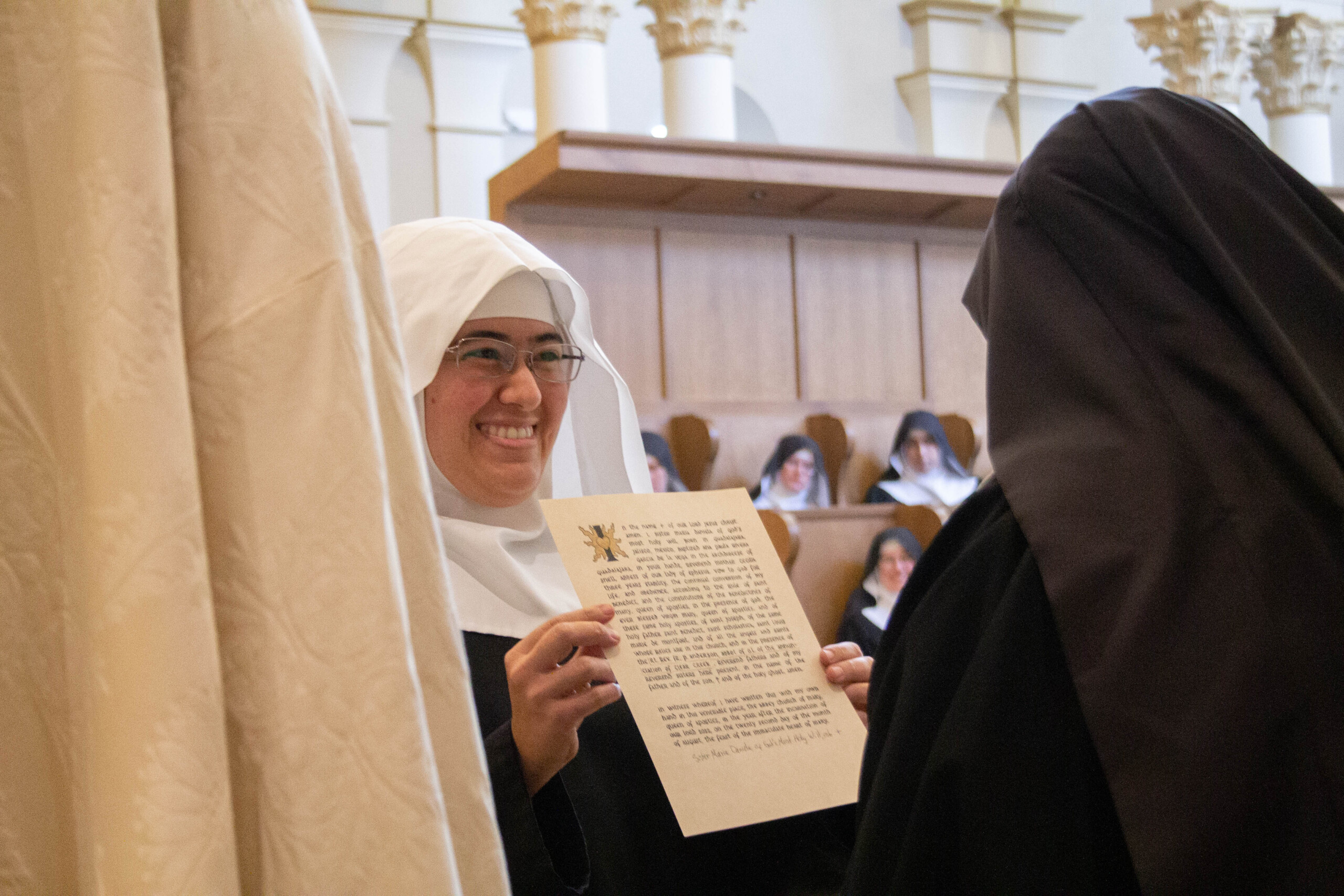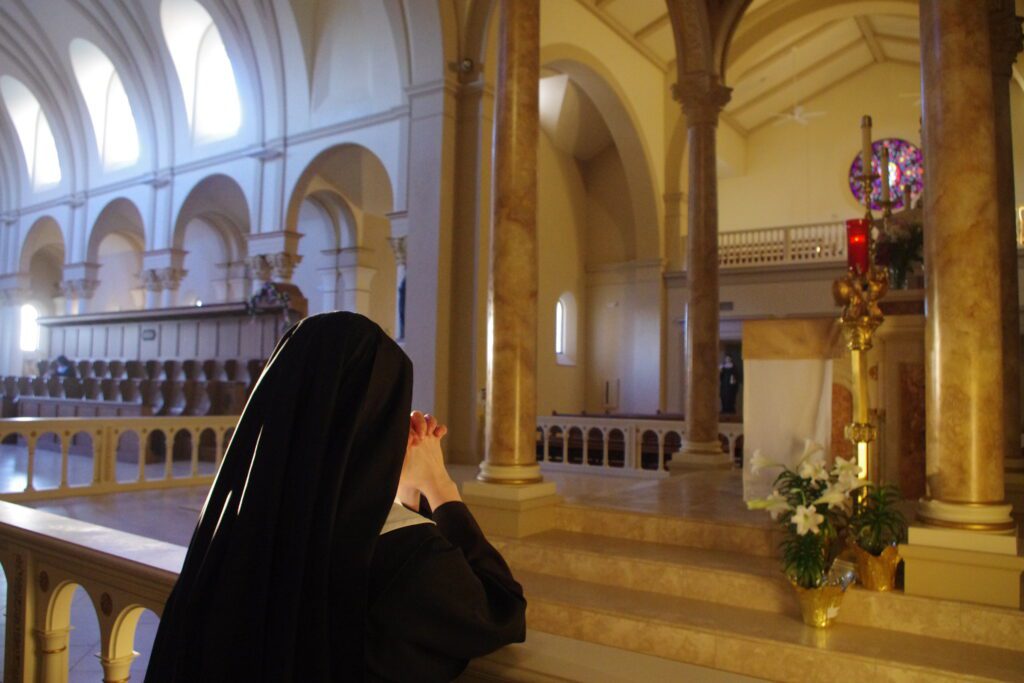Benedictine Vocation
Obedience ~ Stability ~ Conversion of Life

Obedience
The obedience of the monk enlightened by faith is to spring from the love that he bears to Christ as the model and mainspring of his submission. There is not after all any motive more essential and fundamental, more effectual also, for making us perfectly obedient than this ambition to imitate Christ Jesus our ideal. Why have we left all things, renounced all things, even our own will except to follow Him more closely. —Blessed Columba Marmion
The original Latin root for obedience is obaudire. It can be translated as standing by, ready to listen.
This is the approach one must assume in a spirit of loving generosity, and in imitation of Christ who became “obedient unto death.”
Obedience takes humility, a surrendering of one’s own desire for the desires of God at every moment. “Only those hearts inspired by an intense faith, hearts humble, steadfast and generous are capable of it.” (Abbot Marmion)
The Benedictine of Mary strives first and foremost to be obedient to the Church, faithful to the Church’s magisterial teaching and the living authority of the Church in her hierarchy. She vows obedience for life to the Holy Rule, and to its living authority in the Abbess and her successors.
Stability
One thing I ask, this do I seek: to dwell in the house of the Lord all the days of my life. —Psalm 26:4
By the distinctive Benedictine vow of stability, St. Benedict recognized the humble truth that “home is where the heart is.” The heart singly and solely dedicated to God will not wander from where she has been called to pursue Him.
Each sister is bound to stability: perseverance in striving for the heavenly goal within her particular monastery. St. Benedict chose the “most natural framework, in the family” (Dom Delatte) as an ideal atmosphere.
A child is brought up in the home where she will live. So too, the novice is brought up within the family she has chosen, or more properly, the family which God has lovingly chosen for her, from all eternity.
The Benedictine of Mary remains and perseveres with her new family. She seeks no other. The pursuit of eternity is carried out within this context, each sister being bound to it in charity.
A soul rooted in stability will not seek escape, moderation, or even another place where she judges there is a better form of life. She will devote herself to the task at hand in the place where God has led her. Even if obedience may send a sister beyond the geographical bounds of the monastery, she promises faithfully to observe the law of God in the monastic institute by her vows until death.


Conversion of Life
To leave the world and to give up exterior possessions is perhaps something still easy; but for a man to give up himself, to immolate what is most precious to him by surrendering his entire liberty is much more arduous work: to forsake what one has is a small thing, to forsake what one is, that is the supreme gift. —St. Gregory
Within this vow is what the ancient desert Fathers call the “active life,” or the ascetical life: the arduous combat against vices and cultivation of virtues. It is a life-long battle.
Every Benedictine of Mary vows to detach herself from the ways of the world, continually turning to the ways of her Redeemer; “not changing nature, but perfecting the will” (St. John Chrysostom), according to God’s grace and pleasure.
Perfect observance of poverty and chastity is encompassed by the vow of conversion of life, but it demands a great deal more. St. Benedict’s original word for the vow was conversatio, literally a continual turning to the Lord. It is a turning from “the old man,” as St. Paul called our self-will, a turning from everything that is not God with a joyful and generous heart. Following this commitment, one hopes to imitate our Father, St. Benedict, who left the world “to please God alone.” (Dialogues of St. Gregory)


Life Under the Rule
St. Benedict’s is best understood as the spirituality of ordinary life… The Benedictine is a spirituality of work: man’s by labor, God’s by prayer. — John Senior
The Benedictine Rule has ordered all our actions since our foundation. This Rule of Life is read daily, and we strive to keep every aspect of it in all its austere simplicity.
It is in this “little Rule written for beginners,” that we find the pattern to be “doers of the Word;” a time-tested way of life which cultured a barbaric continent by the sheer example of its followers.
The simple motto of “Ora et Labora” (Prayer and Work) summarizes the means our Father Benedict holds out to realize the desire of eternal life.
Becoming a Spouse of Christ


Candidacy and Postulancy
Come, children, hearken to me. I will teach you the fear of the Lord. —Psalm 33
The first step of formation is candidacy. The aspirant requests admittance, and begins to live with the community for two months. She then receives a Miraculous Medal, which continues to be worn throughout life, wears a black dress with a leather belt, and a short veil during the length of her postulancy, which lasts for six to twelve months. No commitments are exchanged.
She is given a course in basic spiritual and doctrinal principles, and learns the ropes of day-to-day living. The postulant is asking God and asking the community to receive her into this particular family. If, after one year, she has discerned that she “belongs,” she may ask to be clothed in the habit and be admitted as a novice.








Novitiate
Should I not willingly entrust myself to the One Who had the good will to save me? He sought me out, he called me through grace; will he refuse me as I come to Him? I fear neither force nor fraud which can snatch me from His hand. — St. Bernard
Her petition having been accepted, the postulant approaches her clothing day, or “Investiture.” St. Gertrude called the day of her Investiture the beginning of her conversion, and rightly so. Here, a decisive break from the world occurs, though prudence and Canon Law prohibit vows until the candidate has proved herself.
The postulant dons a wedding gown to embark upon the long journey of her espousal to Christ. She declares her intention before the community, her family and the Church. Her hair is cut as a sign of her renunciation of self, and she retires to replace her wedding gown with a long, black tunic. Each additional part of the habit is given to her with a prayer, including the white veil.
Finally, as a sign of the new life which she has begun (hence the word “novice”) she is given a lit candle and her new name. Two years of intense prayer and preparation, with more detailed studies and formation in the monastic virtues follow.


First Vows
The more one who shall have renounced earthly desires or possessions to become a disciple of Christ shall advance in His love, the more persons will he find who rejoice to receive Him with heartfelt affection as one of their own, and to sustain him with their own goods; being companions in his profession and life, these make it their delight who has made himself poor for Christ’s sake into their homes and lands and to cherish Him with more devoted love than ever did a wife, a parent, a brother, or a sister according to the flesh. —St. Bede
When her time of novitiate is complete, the novice prostrates before the community to ask prayers and permission to make her vows to God and before her Abbess for a period of three years.
If accepted, the novice processes into Mass on the day of her First Profession with a lit candle, just as she ended her Investiture with one. Her profession, by which she vows Obedience, Stability and Conversion of Life, is within the context of a very symbolic and very rich, traditional ceremony before the Offertory verse of the Mass.
She receives a black veil as a symbol of her death to the world. The period that follows is to ratify the earnestness of the Benedictine. It is a measure of prudence the Church requires as a confirmation of a genuine vocation. She continues her studies and formation during this time.










Solemn Vows
"Suscipe Me Domine, secundum eloquium et vivam;
et non confundas Me ab expectaTione Mea."
In solemn profession, the vows become perpetually binding to Our Lord, her Divine Spouse. At this ceremony, each Sister is called by Our Lord in the person of the Bishop who holds the Church’s authority, and she clearly answers His call.
She repeats her vows using the word “forever” and is given a gold ring, a symbol of her union with Christ and His Church as His bride. She then receives the cuculla to show her full acceptance into monastic life.
Crowned with flowers, she is given her Office book and commissioned by the Church to carry on its praise.


Discernment



When you shall see a soul leave all things to adhere to the Word with all her strength, live by Him, allow herself to be guided by Him, conceive what she should bring forth by Him, a soul, in short who can say for me to live is Christ and to die is gain, then you can indubitably recognize a spouse of Christ.
— St. Bernard
Discernment of a vocation infallibly begins with silence before the Word, openness to His direction and a generous response. A daily heart-to-Heart with the Lord is the beginning of the love story of every Bride of Christ.
Religious life is an attachment to God alone, as the Latin root implies, an anticipation of enjoying Him in this life, “the vestibule of heaven,” as Ven. Maria Teresa Quevedo put it so succinctly. It may be something as simple as a natural inclination toward the religious life that sparks the knowledge of a vocation.
After some initial correspondence with the Novice Mistress, including a questionnaire to be filled out, a young woman may be invited to spend a full week with us. “Lord, where are you staying?” “Come and see,” He told His apostles. (Jn. 1:39)
This visit enables the soul to see if the Lord is calling her to be His spouse within our particular monastic family with its attendant spirituality and charism. This is a very necessary part of the discernment process in order to place oneself within the context of our daily life. She may then write to petition for entry as a candidate.


If you are an unmarried, healthy, Catholic woman practicing the Faith for at least two years, and are between the ages of 16 and 30, you may contact the Novice Mistress through the Contact Us link above.
Or by snail mail:
Novice Mistress
Abbey of Our Lady of Ephesus
8005 NW 316th Street
Gower, MO 64454
Or by snail mail:
If you are an unmarried, healthy, Catholic woman practicing the Faith for at least two years, and are between the ages of 16 and 30, you may contact the Novice Mistress through the Contact Us link above.
Novice Mistress
Abbey of Our Lady of Ephesus
8005 NW 316th Street
Gower, MO 64454










